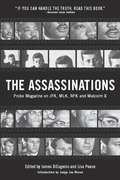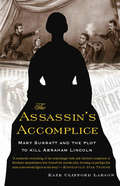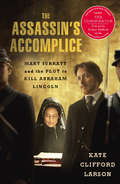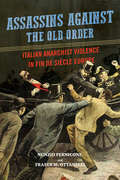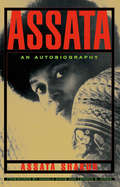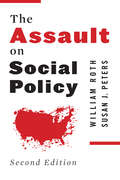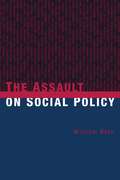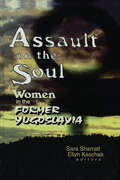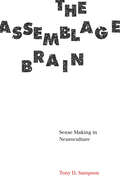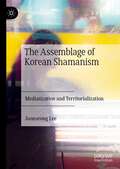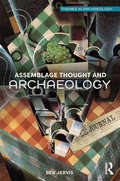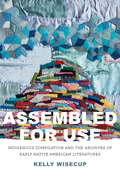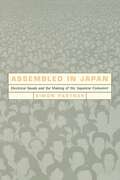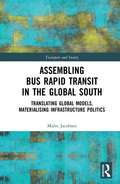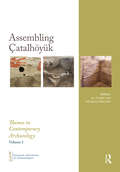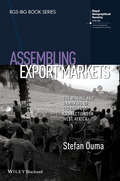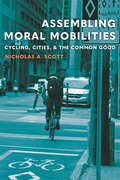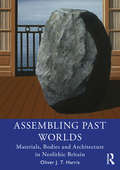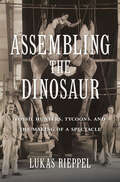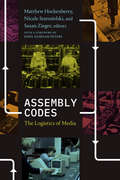- Table View
- List View
The Assassinations
by Lisa Pease James Dieugenio"Probing deep into four hidden histories... the material released should dispel any notions of 'lone nuts' or coincidence... These articles cut a clear path through the thick jungle of disinformation that has grown around these events and expose the truly hideous teratomas that thrive and bloom under the canopy of 'national security.'"--New York Press
The Assassin's Accomplice
by Kate Clifford LarsonSet against the backdrop of the Civil War, The Assassin’s Accomplice tells the gripping story of the conspiracy to assassinate Abraham Lincoln through experience of its only female participant. Confederate sympathizer Mary Surratt ran a boarding house in Washington, and the depth of her complicity in the murder of President Lincoln has been debated since she was arrested on April 17, 1865. Calling upon long-lost interviews, confessions, and court testimony, historian Kate Clifford Larson magnificently captures how Surratt’s actions defied nineteenth-century norms of piety and allegiance. A riveting account of espionage and murder, The Assassin’s Accomplice offers a revealing examination of America’s most remembered assassination.
Assassin's Accomplice, movie tie-in: Mary Surratt and the Plot to Kill Abraham Lincoln
by Kate Clifford LarsonIn The Assassin’s Accomplice, historian Kate Clifford Larson tells the gripping story of Mary Surratt, a little-known participant in the plot to kill Abraham Lincoln, and the first woman ever to be executed by the federal government of the United States. Surratt, a Confederate sympathizer, ran the boarding house in Washington where the conspirators-including her rebel son, John Surratt-met to plan the assassination. When a military tribunal convicted her for her crimes and sentenced her to death, five of the nine commissioners petitioned President Andrew Johnson to show mercy on Surratt because of her sex and age. Unmoved, Johnson refused-Surratt, he said, "kept the nest that hatched the egg. ” Set against the backdrop of the Civil War, The Assassin’s Accomplice tells the intricate story of the Lincoln conspiracy through the eyes of its only female participant. Based on long-lost interviews, confessions, and court testimony, the text explores how Mary’s actions defied nineteenth-century norms of femininity, piety, and motherhood, leaving her vulnerable to deadly punishment historically reserved for men. A riveting narrative account of sex, espionage, and murder cloaked in the enchantments of Southern womanhood, The Assassin’s Accomplice offers a fresh perspective on America’s most famous murder.
Assassins against the Old Order: Italian Anarchist Violence in Fin de Siecle Europe
by Nunzio Pernicone Fraser OttanelliThe image of the anarchist assassin haunted the corridors of power and the popular imagination in the late nineteenth century. Fear spawned a gross but persistent stereotype: a swarthy "Italian" armed with a bloody knife or revolver and bred to violence by a combination of radical politics, madness, innate criminality, and poor genes. That Italian anarchists targeted--and even killed--high-profile figures added to their exaggerated, demonic image. Nunzio Pernicone and Fraser Ottanelli dig into the transnational experiences and the historical, social, cultural, and political conditions behind the phenomenon of anarchist violence in Italy. Looking at political assassinations in the 1890s, they illuminate the public effort to equate anarchy's goals with violent overthrow. Throughout, Pernicone and Ottanelli combine a cutting-edge synthesis of the intellectual origins, milieu, and nature of Italian anarchist violence with vivid portraits of its major players and their still-misunderstood movement. A bold challenge to conventional thinking, Assassins against the Old Order demolishes a century of myths surrounding anarchist violence and its practitioners.
Assata: An Autobiography
by Assata ShakurThis presents the life story of African American revolutionary Shakur, previously known as JoAnne Chesimard.
Assault
by Michael KellyA 24-year-old Limerick man has been remanded in custody in connection with an assault in the city in which a brother of the late councilor Michael Kelly was injured.
The Assault on Social Policy
by Susan Peters William RothA number of groups have intensified their attack on social policy over the past ten years, and this revised textbook reflects these developments, along with new research on the hotly contested policy areas of poverty, welfare, disability, social security, and health care. This edition also considers the recent, ongoing effects of globalization and economic challenges on social policy and includes a new chapter on education.
The Assault on Social Policy
by William Roth Susan PetersBased on incisive analyses of economic globalization, class, politics, and bureaucracy, The Assault on Social Policy examines the ordinary speech used to make poverty and extreme inequality seem acceptable, the corporate strategies co-opting the distribution of wealth and other resources, and the negative effect of these efforts on our more vulnerable citizens, such as those with disabilities, incarcerated individuals, children, and the elderly. <P><P>This second edition incorporates new research on the hotly contested policies dealing with poverty, welfare, disability, social security, and health care. It also takes stock of the ongoing effects of globalization and adds a chapter on education.
The Assault on Social Policy
by William Roth Susan PetersAmerican social policy today largely serves global corporate interests rather than the general public, according to William Roth. Based on incisive analyses of economic globalization, class, politics, and bureaucracy, The Assault on Social Policy argues that the perfection of the free market is a myth. Roth analyzes the rhetoric used to make poverty seem acceptable, shows how corporations affect the distribution of wealth and other resources, and considers the effect on disabled people, criminals, children, and health care. He concludes that increased transnational corporate power has created the need for large-scale systematic public policy changes.
Assault on the Soul: Women in the Former Yugoslavia
by Sara SharrattAssault on the Soul: Women in the Former Yugoslavia sheds light upon women’s wartime experiences and makes sense of their coping strategies in the face of the innumerable atrocities committed against them. This is the only book to present the experiences of therapists, counselors, and other mental health professionals along with attorneys and Justices of the International Criminal Tribunal in working from both psychological and legal perspectives with women in former Yugoslavia. The workers who relate their experiences come from both former Yugoslavia and other nations, representing countries such as Norway, Germany, Holland, Costa Rica and the United States. Focusing on this region offers you a look at applied feminist practice in a cultural context outside the United States or Northern European. Assault on the Soul contains an integration of feminist theories and practice in psychology, women’s history, women’s geography, and women’s jurisprudence. This collection of articles is intended as a historical document, as assurance that both the plight of women and the role of women in bringing it to the attention of the international community and the justice system will not be erased. Assault on the Soul will help you serve your patients’needs by focusing on such issues as: feminist psychology and global issues concerning crimes against women interviews with judges for the International Criminal Tribunal Belgrade feminists’experiences working with female survivors of war supporting women’s projects in the former Yugoslavia traumatized women and the impact of a women-centered training program in Bosnia psychosocial services among refugee women during the war the victims and perpetrators of Serbia reports of rapes, killings, burning villages, and other serious war crimesAssault on the Soul gives you first-hand accounts of war trauma to women. Deeply moving and well written, the articles in this book are written in a combination of legal and psychological approaches to help you teach clients to heal from severe, acute, and chronic trauma.
The Assemblage Brain: Sense Making in Neuroculture
by Tony D. SampsonOnce upon a time, neuroscience was born. A dazzling array of neurotechnologies emerged that, according to popular belief, have finally begun to unlock the secrets of the brain. But as the brain sciences now extend into all corners of cultural, social, political, and economic life, a yet newer world has taken shape: &“neuroculture,&” which goes further than ever before to tackle the profound ethical implications we face in consequence.The Assemblage Brain unveils a major new concept of sense making, one that challenges conventional scientific and philosophical understandings of the brain. Drawing on Deleuze and Guattari, Tony D. Sampson calls for a radical critical theory that operates in the interferences between philosophy, science, art, and politics. From this novel perspective the book is structured around two questions: &“What can be done to a brain?&” and &“What can a brain do?&” Sampson examines the rise of neuroeconomics in informing significant developments in computer work, marketing, and the neuropharmaceutical control of inattentiveness in the classroom. Moving beyond the neurocapitalist framework, he then reestablishes a place for proto-subjectivity in which biological and cultural distinctions are reintegrated in an understanding of the brain as an assemblage. The Assemblage Brain unravels the conventional image of thought that underpins many scientific and philosophical accounts of how sense is produced, providing a new view of our current time in which capitalism and the neurosciences endeavor to colonize the brain.
The Assemblage of Korean Shamanism: Mediatization and Territorialization
by Joonseong LeeThe most unique aspect of Korean shamanism is its mysterious duality that continually reiterates the processes of deterritorialization and reterritorialization. This book approaches that puzzle of mysterious duality using an interdisciplinary lens. Korean shamanism has been under continuous oppression and marginalization for a long time, and that circumstance has never dissipated. Shaman culture can be found in every corner of people’s lives in contemporary Korea, but few acknowledge their indigenous beliefs with pride. This mysterious duality has deepened as the mediatization process of Korean shamanism has developed. Korean shamanism was revived as the dynamic of shamanic inheritance in the process, but these dynamics have also become the object of mockery. For this reason, any true understanding of Korean shamanism rests in how to unravel the unique puzzles of this mysterious duality. In this book, the duality is mapped out by playing with the puzzles surrounding the contextualization of Korean shamanism and mediatization.
Assemblage Thought and Archaeology (Themes in Archaeology Series)
by Ben JervisFrom examinations of prehistoric burial to understanding post-industrial spaces and heritage practices, the writing of Gilles Deleuze and Felix Guattari is gaining increasing importance within archaeological thought. Their concept of ‘assemblages’ allows us to explore the past in new ways, by placing an emphasis on difference rather than similarity, on fluidity rather stasis and unpredictability rather than reproduceable models. Assemblage Thought and Archaeology applies the notion of assemblage to specific archaeological case studies, ranging from early urbanism in Mesopotamia to 19th century military fortifications. It introduces the concept of assemblage within the context of the wider ‘material turn’ in the social sciences, examines its implications for studying materials and urban settlements, and explores its consequences for the practice of archaeological research and heritage management. This innovative book will be of particular interest to postgraduate students of archaeological theory and researchers looking to understand this latest trend in archaeological thought, although the case studies will also have appeal to those whose work focusses on material culture, settlement archaeology and archaeological practice.
Assembled for Use: Indigenous Compilation and the Archives of Early Native American Literatures (The Henry Roe Cloud Series on American Indians and Modernity)
by Kelly WisecupA wide-ranging, multidisciplinary look at Native American literature through non-narrative texts like lists, albums, recipes, and scrapbooks &“An intricate history of Native textual production, use, and circulation that reshapes how we think about relationships between Native materials and settler-colonial collections.&”—Rose Miron, D&’Arcy McNickle Center for American Indian and Indigenous Studies at the Newberry Library Kelly Wisecup offers a sweeping account of early Native American literatures by examining Indigenous compilations: intentionally assembled texts that Native people made by juxtaposing and recontextualizing textual excerpts into new relations and meanings. Experiments in reading and recirculation, Indigenous compilations include Mohegan minister Samson Occom&’s medicinal recipes, the Ojibwe woman Charlotte Johnston&’s poetry scrapbooks, and Abenaki leader Joseph Laurent&’s vocabulary lists. Indigenous compilations proliferated in a period of colonial archive making, and Native writers used compilations to remake the very forms that defined their bodies, belongings, and words as ethnographic evidence. This study enables new understandings of canonical Native writers like William Apess, prominent settler collectors like Thomas Jefferson and Henry Rowe Schoolcraft, and Native people who contributed to compilations but remain absent from literary histories. Long before current conversations about decolonizing archives and museums, Native writers made and circulated compilations to critique colonial archives and foster relations within Indigenous communities.
Assembled in Japan: Electrical Goods and the Making of the Japanese Consumer
by Simon PartnerAssembled in Japan investigates one of the great success stories of the twentieth century: the rise of the Japanese electronics industry. Contrary to mainstream interpretation, Simon Partner discovers that behind the meteoric rise of Sony, Matsushita, Toshiba, and other electrical goods companies was neither the iron hand of Japan's Ministry of International Trade and Industry nor a government-sponsored export-led growth policy, but rather an explosion of domestic consumer demand that began in the 1950s.This powerful consumer boom differed fundamentally from the one under way at the same time in the United States in that it began from widespread poverty and comparatively miserable living conditions. Beginning with a discussion of the prewar origins of the consumer engine that was to take off under the American Occupation, Partner quickly turns his sights on the business leaders, inventors, laborers, and ordinary citizens who participated in the broadly successful effort to create new markets for expensive, unfamiliar new products.Throughout, the author relates these pressure-cooker years in Japan to the key themes of twentieth-century experience worldwide: the role of technology in promoting social change, the rise of mass consumer societies, and the construction of gender in advanced industrial economies.
Assembling Bus Rapid Transit in the Global South: Translating Global Models, Materialising Infrastructure Politics (Transport and Society)
by Malve JacobsenThis book explores the mobile ethnography of Dar es Salaam, where consultants and politicians have planned and implemented a bus rapid transit (BRT) system for two decades. It analyses the dual processes of assembling BRT in the Tanzanian metropolis and establishing BRT as a policy model of and for the Global South. The book elucidates how policy models are constructed and circulated around the globe and depicts the processes by which they are translated between, and materialise within, specific contexts. It presents the case of BRT to demonstrate how technocrats shape these processes through persuasive work aimed at disseminating and stabilising this transport model, and how local actors influence its adaptation in Dar es Salaam. The book adopts a ‘double mobility’ approach to show how this ethnography follows travelling consultants, circulating policies and moving buses to explore the fluidity of the BRT model. Linking key debates in policy mobility studies and Science and Technology Studies, enriched with postcolonial perspectives and geographies of transport and infrastructure, it offers new insights into the technopolitics of planning and implementing infrastructure systems. This book will appeal to academics and students of human geography, transport studies, science and technology studies, and African and development studies interested in the technopolitics of transport planning.
Assembling Çatalhöyük (Themes in Contemporary Archaeology)
by Ian Hodder Arkadiusz Marciniak"Assembling ?�alh?�??k, like archaeological remains, can be read in a number of ways. At one level the volume reports on the exciting new discoveries and advances that are being made in the understanding of the 9000 year-old Neolithic site of ?�alh?�??k. The site has long been central to debates about early village societies and the formation of ��mega-sites��in the Middle East. The current long-term project has made many advances in our understanding of the site that impact our wider understanding of the Neolithic and its spread into Europe from the Middle East. These advances concern use of the environment, climate change, subsistence practices, social and economic organization, the role of religion, ritual and symbolism. At another level, the volume reports on methodological advances that have been made by team members, including the development of reflexive methods, paperless recording on site, the integrated use of 3D visualization, and interactive archives. The long-term nature of the project allows these various innovations to be evaluated and critiqued. In particular, the volume includes analyses of the social networks that underpin the assembling of data, and documents the complex ways in which arguments are built within quickly transforming alliances and allegiances within the team. In particular, the volume explores how close inter-disciplinarity, and the assembling of different forms of data from different sub-disciplines, allow the weaving together of information into robust, distributed arguments."
Assembling Export Markets: The Making and Unmaking of Global Food Connections in West Africa (RGS-IBG Book Series)
by Stefan OumaAssembling Export Markets explores the new ‘frontier regions’ of the global fresh produce market that has emerged in Ghana over the past decade. Represents a major and empirically rich contribution to the emerging field of the social studies of economization and marketization Offers one of the first ethnographic accounts on the making of global commodity chains ‘from below’ Denaturalizes global markets by unpacking their local engagement, materially entangled construction, need for maintenance, and fragile character Offers a trans-disciplinary engagement with the construction and extension of market relations in two frontier regions of global capitalism Critically examines the opportunities and risks for firms and farms in Ghana entering global fresh produce markets
Assembling Financialisation: Local Actors and the Making of Agricultural Investment
by Zannie LangfordFarmers, Indigenous organisations, government and private-sector intermediaries from remote Northern Australia often negotiate with private finance capital to gain funds for agricultural development.The concept of financialisation is used to explore the drivers and effects of agrifood restructuring in the area, while assemblage theory is applied to position local actors as potential sites of power in negotiating connections between local spaces and global finance. This book demonstrates that while financialisation is a useful signifier of patterns of global change, it is assembled by a diverse range of often contradictory work.
Assembling Health Rights in Global Context: Genealogies and Anthropologies
by Alex Mold David ReubiWhat do we mean when we talk about rights in relation to health? Where does the language of health rights come from, and what are the implications of using such a discourse? During the last 20 years there have been an increasing number of initiatives and efforts – for instance in relation to HIV/AIDS – which draw on the language, institutions and procedures of human rights in the field of global health. This book explores the historical, cultural and social context of public health activists’ increasing use of rights discourse and examines the problems it can entail in practice. Structured around three interlinked themes, this book begins by looking at what health as a right means for our understandings of citizenship and political subjectivities. It then goes on to look at how and why some health problems came to be framed as human rights issues. The final part of the book investigates what happens when health rights are put into practice – how these are implemented, realised, cited, ignored and resisted. Assembling Health Rights in Global Context provides an in-depth discussion of the historical, anthropological, social and political context of rights in health and develops much needed critical perspectives on the human rights approach to global health. It will be of interest to scholars of public health and human rights within health care as well as sociology and anthropology.
Assembling Moral Mobilities: Cycling, Cities, and the Common Good
by Nicholas A. ScottIn the years since the new mobilities paradigm burst onto the social scientific scene, scholars from various disciplines have analyzed the social, cultural, and political underpinnings of transport, contesting its long-dominant understandings as defined by engineering and economics. Still, the vast majority of mobility studies, and even key works that mention the &“good life&” and its dependence on the car, fail to consider mobilities in connection with moral theories of the common good. In Assembling Moral Mobilities Nicholas A. Scott presents novel ways of understanding how cycling and driving animate urban space, place, and society and investigates how cycling can learn from the ways in which driving has become invested with moral value. By jointly analyzing how driving and cycling reassembled the &“good city&” between 1901 and 2017, with a focus on various cities in Canada, in Detroit, and in Oulu, Finland, Scott confronts the popular notion that cycling and driving are merely antagonistic systems and challenges social-scientific research that elides morality and the common good. Instead of pitting bikes against cars, Assembling Moral Mobilities looks at five moral values based on canonical political philosophies of the common good, and argues that both cycling and driving figure into larger, more important &“moral assemblages of mobility,&” finally concluding that the deeper meta-lesson that proponents of cycling ought to take from driving is to focus on ecological responsibility, equality, and home at the expense of neoliberal capitalism. Scott offers a fresh perspective of mobilities and the city through a multifaceted investigation of cycling informed by historical lessons of automobility.
Assembling Past Worlds: Materials, Bodies and Architecture in Neolithic Britain
by Oliver J.T. HarrisAssembling Past Worlds draws on new materialism and the philosophy of Gilles Deleuze to explore the potential for a posthumanist archaeology. Through specific empirical study, this book provides a detailed analysis of Neolithic Britain, a critical moment in the emergence of new ways of living, as well as new relationships between materials, people and new forms of architecture. It achieves two things. First, it identifies the major challenges that archaeology faces in the light of current theoretical shifts. New ideas place new demands on how we write and think about the past, sometimes in ways that can seem contradictory. This volume identifies seven major challenges that have emerged and sets out why they matter, why archaeology needs to engage with them and how they can be dealt with through an innovative theoretical approach. Second, it explores how this approach meets these challenges through an in-depth study of Neolithic Britain. It provides an insightful diagnosis of the issues posed by current archaeological thought and is the first volume to apply the philosophy of Gilles Deleuze to the extended analysis of a single period. Assembling Past Worlds shows how new approaches are transforming our understandings of past worlds and, in so doing, how we can meet the challenges facing archaeology today. It will be of interest to both students and researchers in archaeological theory and the Neolithic of Europe.
Assembling the Dinosaur: Fossil Hunters, Tycoons, and the Making of a Spectacle
by Lukas RieppelA lively account of the dinosaur’s role in Gilded Age America, examining the connection between business, paleontology, and museums.Although dinosaur fossils were first found in England, a series of dramatic discoveries during the late 1800s turned North America into a world center for vertebrate paleontology. At the same time, the United States emerged as the world’s largest industrial economy, and creatures like Tyrannosaurus, Brontosaurus, and Triceratops became emblems of American capitalism. Large, fierce, and spectacular, American dinosaurs dominated the popular imagination, making front-page headlines and appearing in feature films.Assembling the Dinosaur follows dinosaur fossils from the field to the museum and into the commercial culture of North America’s Gilded Age. Business tycoons like Andrew Carnegie and J. P. Morgan made common cause with vertebrate paleontologists to capitalize on the widespread appeal of dinosaurs, using them to project American exceptionalism back into prehistory. Learning from the show-stopping techniques of P. T. Barnum, museums exhibited dinosaurs to attract, entertain, and educate the public. By assembling the skeletons of dinosaurs into eye-catching displays, wealthy industrialists sought to cement their own reputations as generous benefactors of science, showing that modern capitalism could produce public goods in addition to profits. Behind the scenes, museums adopted corporate management practices to control the movement of dinosaur bones, restricting their circulation to influence their meaning and value in popular culture.Tracing the entwined relationship of dinosaurs, capitalism, and culture during the Gilded Age, Lukas Rieppel reveals the outsized role these giant reptiles played during one of the most consequential periods in American history.Praise for Assembling the Dinosaur“A penetrating study of legitimacy and capitalism in the realm of fossils.” —Verlyn Klinkenborg, The New York Review of Books“A solid entry into the growing body of literature on Gilded Age American paleontology, but it is particularly valuable for its contribution to enhancing our understanding of how science and its representation during that period were influenced by, and in turn affected, society as a whole. By incorporating cultural, economic, and scientific developments, Rieppel shines new light on the history of both American paleontology and museum exhibition practice.” —Ilja Nieuwland, Science
Assembling Therapeutics: Cultures, Politics and Materiality (Therapeutic Cultures)
by Suvi Salmenniemi Johanna Nurmi Inna Perheentupa Harley BergrothThis volume examines the ways in which people engage with therapeutic practices, such as life coaching, mindfulness, complementary and alternative medicine, sex and relationship counselling, spiritual healing and self-tracking. It investigates how human and non-human actors, systems of thought and practice are assembled and interwoven in therapeutic engagements, and traces the situated, material and political dimensions of these engagements. By focusing on lived experiences through ethnographically informed case studies, the book elucidates the diverse forms, meanings and embodied effects of therapeutic engagements in different settings, as well as their potential for both oppressive and subversive social change. In this way, Assembling Therapeutics contributes to our understanding of multiple modes of healing, self-knowledge and power in contemporary societies.
Assembly Codes: The Logistics of Media
by Matthew Hockenberry, Nicole Starosielski, and Susan ZiegerThe contributors to Assembly Codes examine how media and logistics set the conditions for the circulation of information and culture. They document how logistics—the techniques of organizing and coordinating the movement of materials, bodies, and information—has substantially impacted the production, distribution, and consumption of media. At the same time, physical media, such as paperwork, along with media technologies ranging from phone systems to software are central to the operations of logistics. The contributors interrogate topics ranging from the logistics of film production and the construction of internet infrastructure to the environmental impact of the creation, distribution, and sale of vinyl records. They also reveal how logistical technologies have generated new aesthetic and performative practices. In charting the specific points of contact, dependence, and friction between media and logistics, Assembly Codes demonstrates that media and logistics are co-constitutive and that one cannot be understood apart from the other.ContributorsEbony Coletu, Kay Dickinson, Stefano Harney, Matthew Hockenberry, Tung-Hui Hu, Shannon Mattern, Fred Moten, Michael Palm, Ned Rossiter, Nicole Starosielski, Liam Cole Young, Susan Zieger
